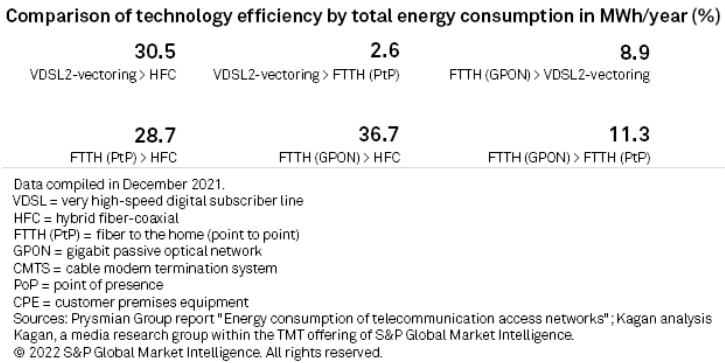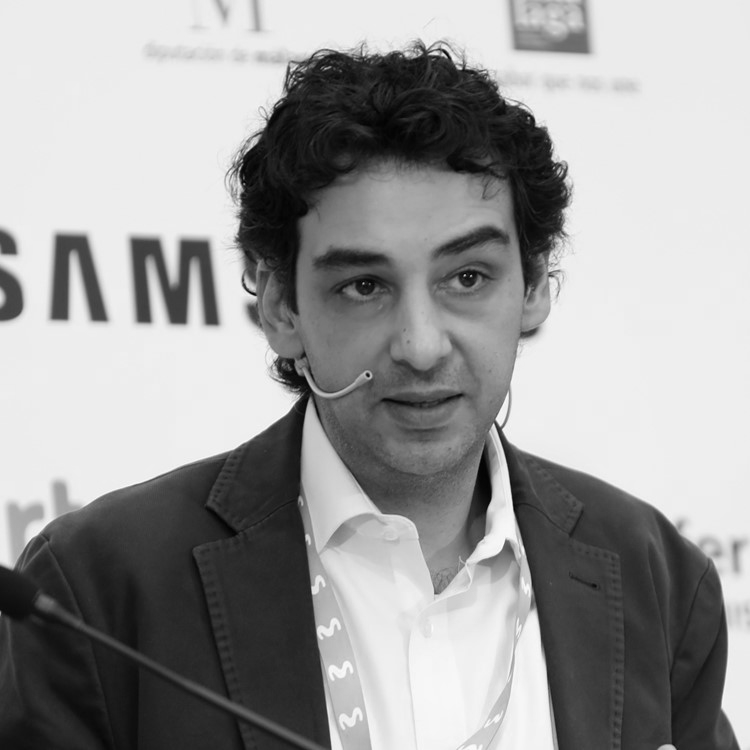S&P Global Offerings
Featured Topics
Featured Products
Events
S&P Global Offerings
Featured Topics
Featured Products
Events
S&P Global Offerings
Featured Topics
Featured Products
Events
Banking & Capital Markets
Economy & Finance
Energy Transition & Sustainability
Technology & Innovation
Podcasts & Newsletters
Banking & Capital Markets
Economy & Finance
Energy Transition & Sustainability
Technology & Innovation
Podcasts & Newsletters
S&P Global Offerings
Featured Topics
Featured Products
Events
Blog — 4 Feb, 2022
As sustainable and green technologies go, many operators consider fiber rollouts to be key to achieving environmental goals. When Kagan recently surveyed 101 telecom and 42 cable professionals across the globe, only 19% of the respondents specified that environmental impact was not a driver in the decision to upgrade to fiber, with 35% of respondents attached to European telcos and 38% to European cable operators. Yet, the technology alone is not enough to achieve environmental goals, and governments and companies still have some way to go before knitting together a holistic approach.
Kagan estimates Western Europe's fiber penetration at 22.2% in 2021, with Sweden as high as 69.1% and Greece as low as 0.2%. Most countries in the region have fiber plans in place, and as rollouts gather pace, our current estimate, based on existing plans, will see penetration just shy of 50% by 2030.
So how much more efficient is fiber? A study conducted in 2021 by Prysmian Cavi e Sistemi Italia Srl — an Italian telecom and energy cabling manufacturer also known as Prysmian Group — found that gigabit passive optical networks provide an 8.9% improvement in total energy consumption (MWh/year) when compared with VDSL-vectoring, and 36.7% versus hybrid fiber-coaxial. The advantage of GPONs from an energy efficiency perspective is the fact that they are passive, with no active optical elements between the central office and the end customer. Interestingly, fiber to the home point-to-point (as opposed to the point to multipoint structure in GPONs, and providing a single, rather than shared, fiber strand to each premises) is 2.7% less efficient than VDSL. While FTTH-PtP costs are higher, the technology supports much higher performance as well as greater product differentiation and individual line upgrade capabilities.

Belgium's incumbent telco Proximus highlighted fiber's environmental credentials, noting that data transmission over fiber uses "up to 12 times less energy" than on copper. Moreover, the firm highlights that fiber is made of silicon dioxide, with silicon being "the second most abundant element on earth, after oxygen," and its exploitation "is not harmful to the environment." Proximus adds that the use and production of "2 kg of copper wire results in the emission of 1,000 kg of CO2" compared with fiber's meager 0.06 kg.
The exploitation issue extends from source materials to delivery — labor and supply lines — and installation, all of which can have their own ESG impacts. Ensuring that the whole process is "clean" will be a challenge, take time, and require government involvement.
Nordic operator Telia Company AB (publ) said in its 2020 annual report that as much as 86% of its value chain emissions are generated in its supply chain. The company is using its influence to work with peers and companies in other sectors to help instill low-carbon operations and manufacturing, promote science-based targets to cut absolute greenhouse gas emissions by at least 50% by 2030, and achieve climate neutrality — zero greenhouse gas emissions — in its value chains by 2030 (including subcontractors). At year-end, suppliers representing 16% of total supply chain emissions had set science-based targets.
In Germany, the federal parliament passed an act on corporate due diligence obligations in June 2021 to minimize any negative social and environmental impact of activities associated with companies' supply chains. The new legislation will come into effect in 2023. In France, the state had moved earlier, in 2017, with a law whose name translates as the "law relating to the duty of care of parent companies and donor companies." Commonly referred to as the Duty of Care law or the Duty of Vigilance law, it obliges local companies to devise and implement measures to mitigate social and environmental risks as well as report on such actions and the risks themselves.
As clear as fiber's benefits are, so too is the massive expected growth in data consumption, which increases energy use by supporting even more devices (think charging, connectivity) and increases demand for data centers, among other factors, potentially offsetting the gains made in network efficiency.
Improving energy efficiency has obvious benefits, especially on mobile networks given the scale of traffic growth, from cost controls to cutting negative environmental effects. Solutions include the use of more efficient cooling systems in data centers, the decommissioning of legacy systems that are less energy-efficient such as copper and the deployment of new software technologies that can reduce energy use in mobile network sites. Ultimately, current gains in 5G efficiency — 5G technology is up to 90% more efficient than 4G in terms of energy consumption per unit of traffic (W/Mbps) — according to trials conducted by Ericsson and Telefónica SA — will likely be trumped by the predicted 343.1% increase in global data traffic between 2021 and 2027.
Decommissioning copper
On fixed networks, the clearest short-term benefit for the operators in terms of both ESG and revenue will be the retirement of copper networks in Europe, and cable's eventual shift to full fiber. Timelines for the network shutdowns are still not universally transparent in Europe, given that much relies on the transition to fiber and third party network carriers' shift to the new networks. Kagan tracks the development of copper switch off plans in Western Europe.
An additional benefit to shutting down copper networks is recycling. Proximus said its decommissioning of copper creates a stockpile of 500 tonnes of copper each year. At the COMEX average price for 2021 of $4.24 per pound, this equates to an annual value of $4.7 million. Copper is recovered from the ground during fiber installation and other assigned works, both outside and inside buildings. Proximus informed Kagan that from 2016 to year-end 2020 it had dismantled 2,800 km of copper network, which yielded more than 2,600 tonnes of copper for recycling — valued at an estimated $24.3 million at 2021 average prices.
The firm removed 561 km of old copper cables in 2021 on the back of simplification and modernization of the network. It reached 150% of its target for 2021, with more than 752 tonnes recycled as of end-November 2021.
Group action
Momentum for sustainable technology moved beyond individual action in Europe, as members of GIGAEurope — a group consisting of private gigabit network investors Liberty Global B.V., NOS (Portugal), TDC A/S (Denmark and Nordics) and Vodafone Group PLC — founded the European Green Digital Coalition, which signed a declaration in March 2021. The aim is to engage with organizations to establish scientifically grounded objectives using standardized and common methodologies for greenhouse gas emissions to be reduced by 2030, with a target that by 2040 emissions are climate-neutral or are balanced by initiatives that remove greenhouse gases from the atmosphere, so-called Net Zero.
Additional plans include continued improvement in networks and data centers, developing and rolling out green digital technologies that provide measurable energy efficiency to drive a cross-sector net positive impact. Priority sectors identified are energy, transport, manufacturing, agriculture and construction. The aim is to engage with these industries to flesh out guidelines and best practice for the implementation of green digital technology, and to drive the adoption of new skills for personnel.
Meanwhile, Telia noted that it participates in several key initiatives: the Exponential Roadmap, the 1.5°C Business Playbook and SME Climate Hub. In September 2020, Telia, Ericsson, British Telecom, consumer goods company Unilever PLC and retailer Ingka Holding BV-owned Ikea AB founded the 1.5°C Supply Chain Leaders to establish exponential climate action in global supply chains. Telefónica, food and beverage company Nestlé SA and waste management firm Ragn-Sells AB joined in December 2020.

